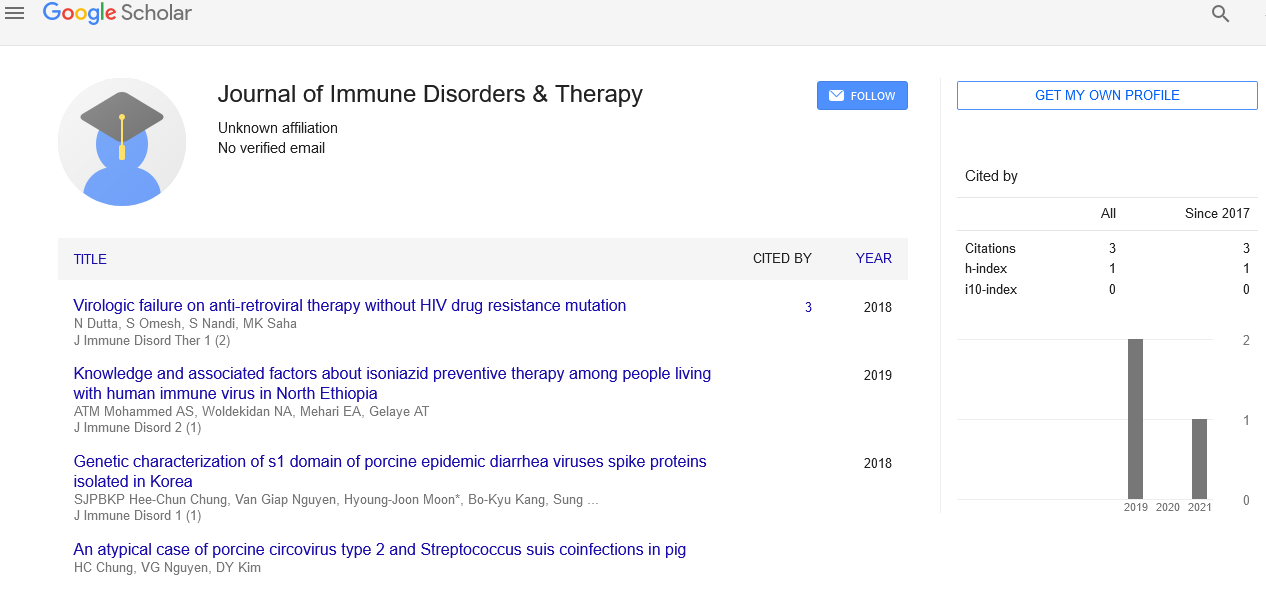Autoantibodies in Autoimmune Diseases
Received: 03-Dec-2021 Accepted Date: Dec 17, 2021; Published: 24-Dec-2021
This open-access article is distributed under the terms of the Creative Commons Attribution Non-Commercial License (CC BY-NC) (http://creativecommons.org/licenses/by-nc/4.0/), which permits reuse, distribution and reproduction of the article, provided that the original work is properly cited and the reuse is restricted to noncommercial purposes. For commercial reuse, contact reprints@pulsus.com
Abstract
Commentary
Antinuclear antibodies (ANAs) and rheumatoid elements (RFs) were the primary autoantibodies found in the last part of the 1940s, when they were portrayed as serum factors that could tie atomic antigens and immunoglobulins, individually. ANA and RF have been distinguished as symptomatic qualities in SLE and RA, separately, as well as supporters of illness etiology. Autoantibodies have a basic influence in the pathophysiology of numerous illnesses, and autoantibodies cause both foundational irritation and tissue injury, it is ending up being unmistakable. Autoreactivity is restrained during B cell improvement in the BM by receptor altering, demise, and enlistment of anergy in B cells conveying an autoreactive B cell receptor (BCR). Acknowledgment of a self-antigen in the BM can set off these cycles in juvenile B cells that produce surface IgM. Momentary B cells that rise up out of the BM create in the spleen, which has extra resilience instruments. The particular cycles in this fringe compartment are obscure, albeit probably require BCR ligand acknowledgment, like the resistance designated spots in the BM. Deeply (GC). B cell clonal expansion, liking development, class exchanging, and separation to memory B cells or plasma cells all occur in the GC. The way that GC-developed B cells have encountered significant physical transformation of the immune response qualities is a distinctive characteristic. Extra resilience designated spots in the post-GC compartment have been proposed to actually forestall autoreactivity in memory B cells and plasma cells, through one or the other apoptosis or receptor altering, in light of the fact that substantial hypermutation can cause anew autoreactivity as well as upgrade proclivity of existing autoreactive B cells. The ability to succession and clone Ig qualities from single B cells has permitted scientists to examine these resilience designated spots in wellbeing and infection. As per the discoveries of such examinations using B cells from sound individuals, the BM creates countless autoreactive B cells, and successive resilience designated spots lead to a consistent diminishing in autoreactivity as the B cells mature. To lay out and keep up with the GC, related B cell/T cell cooperations are expected for the improvement of high-fondness antibodies. Since the presence of autoantibodies is ordinarily associated with the presence of explicit HLA alleles, substantially altered autoantibodies in immune system sickness are thought to be delivered through T cell-subordinate cycles. Nonetheless, nothing is had some significant awareness of the explicitness of T aide cells that can set off B cells to create autoantibodies. Through subatomic mimicry between viral or bacterial antigens and self-antigens, T cell help for autoantibody-creating B cells can likewise come from T cell reactions to unfamiliar antigens. Unfamiliar antigens can enact nonautoreactive T cells, which then, at that point, initiate B cells, which recognize the unfamiliar antigen yet additionally cross-respond with a self-antigen. Such initiation is remembered to prompt the choice and development of high-proclivity selfresponsive B cells. Autoantibodies can be coordinated against nucleic acids, lipids, or proteins, and these antigens can be found in the core or cytoplasm, on the cell surface, or in the extracellular milieu. While taking a gander at autoantibodies in the most well-known fundamental immune system sicknesses, obviously by far most of them target generally communicated intracellular parts. The most regular are ANAs, which are a gathering of heterogeneous antibodies that focus on various novel atomic parts. Since the synthetic compounds distinguished by ANAs are for the most part found in the core, antibodies and B cells can’t get to them. Atomic substance are just released into the extracellular climate in case of cell passing.
Acknowledgement
The authors are grateful to the journal editor and the anonymous reviewers for their helpful comments and suggestions.
Conflict of Interest
The authors declared no potential conflicts of interest for the research, authorship, and/or publication of this article.





